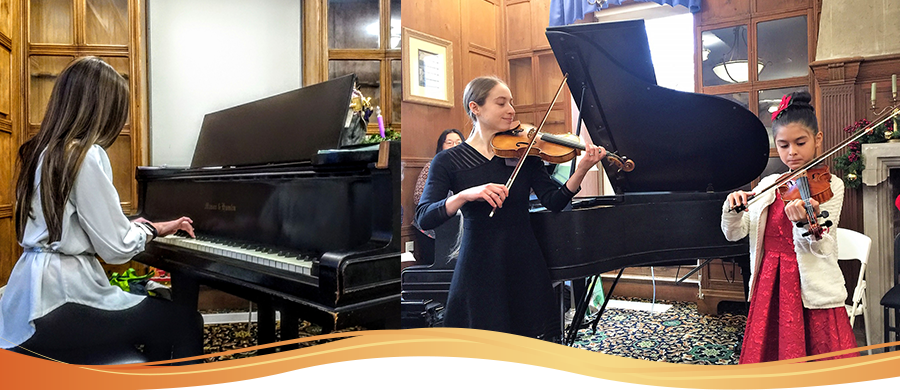
Online
Music for the Community
If you're interested in a particular category, you can sort performances by student age, instrument, singalong music, composer and so on - click on the orange tags under the text. We hope you and your family will enjoy watching our students share their music!
To have each week's videos and accompanying info sent to your inbox*, please subscribe via the orange button.
*Videos are delivered twice weekly; you can unsubscribe at any time, and we will never share or sell your info.
Subscribe to this Page
Displaying items by tag: Violin
Day 60 - Mozart Violin Concerto in D major
Violinist age 14 plays Mozart's Violin Concerto #4 in D, first movement
Wolfgang Amadeus Mozart (born 1756) wrote at least five violin concertos between 1773 and 1776, when he was not much older than this student. He probably wrote them for himself to play in his position as concertmaster (first chair) of the Archbishop of Salzburg’s orchestra.
This one was written in 1775, when he was 19. He did perform it at the time – but after he left the orchestra, he updated it and made it harder for the new concertmaster (Antonio Brunetti) who took over his job! It’s nicknamed the “Military” concerto, and if you listen to the violinist’s opening few measures you’ll hear why – they sound rather like a brass fanfare.
We love it when our older students play beautiful works like this with ease, inspiring beginner and intermediate students with a vision of what can happen if they keep on practicing. But as we make sure to point out to them: students like this were also once beginners learning to pluck open strings, just like the young man in yesterday’s video!
Day 59 - Cross Lake Blues
Violinist age 7 plays "Cross Lake Blues" by Joanne Martin
Parents are often surprised when we invite their very new beginner to play in an upcoming recital! But if the memory of your own childhood recitals makes your palms sweat - think again: our recitals are very supportive and festive events, where even students who’ve had only a few weeks of lessons can share pieces using just one or two notes, and find themselves enthusaistically celebrated for doing so.
This jazzy piece from Joanne Martin’s “Magic Carpet” album is a favorite of our violin beginners, as all you need to play it is two open strings, A and E. In spite of that it’s a fun recital piece, and a great way to dip your toe into playing for an audience. Experiences like this get our students feeling comfortable right from the start with the idea of sharing their music with others - as you can see throughout this Music for the Community series.
Day 56 - Handel Sarabande
Violinist age 14 plays "Sarabande" by Handel
It's probably no surprise that Georg Frederic Handel (1685-1759), an exact contemporary of Bach, also wrote many pieces featuring the dance forms that were popular among composers at the time. But it's hard to believe that the stately sarabande was originally thought to be a terrible influence - it was described in a "Treatise Against Public Amusements" in 1609 as "enough to excite bad emotions in even very decent people"!
The Sarabande probably had its origins in Central America, in particular Guatemala and Mexico, in the 16th century. It was actually banned in Spain by King Philip II in 1583, thanks to the sentiments above - but that didn't stop it being performed. It spread to Italy in the 17th century, and then - thanks to composers like Handel and Bach, who often used it in their suites of dances - to France, where it became a popular slow court dance.
Having started his career in his native Germany, in 1710 Handel became Kapellmeister (Music Director) at the court of Prince George of Hanover. But in 1714 Prince George became King George I of England, and Handel's success in England led him to settle there permanently. His famous "Water Music" suite was performed several times on barges on the River Thames for the King and his guests. In 1727 Handel was commissioned to write four anthems for the Coronation ceremony of the next king, George II, and one of these anthems, "Zadok the Priest", has been played at every British coronation ceremony since.
Day 55 - Bach Concerto for Two Violins
Violinists age 12 and 16 play Bach Concerto in D minor for Two Violins, second movement
The beloved "Bach Double", one of the composer's most famous works, is usually recognized by its fast first movement. Here, though, we're featuring the lyrical second movement with its expansive, lilting melody. The two violinists have equal parts that weave in and out of each other in a soulful musical conversation in the flowery Baroque style, taking turns with the melody and the accompaniment, finally coming to rest together.
Bach probably wrote this concerto when he was "Kapellmeister" - Director of Music - at the court Prince Leopold of Anhalt-Cothen between 1717 and 1723. This was a very happy employment situation for Bach - Prince Leopold, who was a musician himself, appreciated Bach's talents, paid him well, and gave him a lot of freedom to compose and perform whatever suited him. Much of the music of Bach that we've shown in this series comes from this time, including the orchestral suites and cello suites, as well as his music based on 18th century dances (here, here, and here).
Day 54 - Allegro by Fiocco
Violinist age 12 plays "Allegro" by Fiocco
Joseph-Hector Fiocco (1703 – 1741), born in Brussels, Belgium, was a composer and harpsichordist of the late Baroque period. His father, Italian composer Pietro Antonio Fiocco, and his older step-brother Jean-Joseph Fiocco gave him much of his musical education. He also learned Greek and Latin well enough to be able to become a schoolteacher in both those subjects.
He became music director at the cathedral in Antwerp, so much of the music he wrote was choral and religious in nature. He also wrote two suites of pieces for harpsichord - but ironically his best-known piece is this Allegro for violin, played by intermediate violinists the world over. "Allegro" literally means "happy", but in musical terms it means "fast and lively", and that's certainly the case with this piece!
Day 51 - The Happy Farmer
Violinist age 8 plays "The Happy Farmer"
German composer and pianist Robert Schumann lived from 1810 to 1856. He was a brilliant pianist and intended to make a career as a perfomer. Unfortunately a hand injury put an end to that idea, so thereafter he focused on composing.
Meanwhile, he had fallen in love with his piano teacher's daughter, Clara Wieck - herself a wonderful pianist - but her father was very opposed to their marriage. Robert eventually won out, though, and married her in 1840 after a court battle.
By 1848 he and Clara had three young daughters (they eventually had eight children, seven of whom survived). He composed a collection of 43 easy piano pieces for them, "Album for the Young", and The Happy Farmer is one of these pieces. As with our other singalong songs, the words reflect the musical structure, which is little unusual here: A1 - A1 - B - A2 - B - A2, with the A section having two different endings. The B section is very short: the farmer (A) barely lets his wife (B) get a word in edgewise before interrupting her again!


